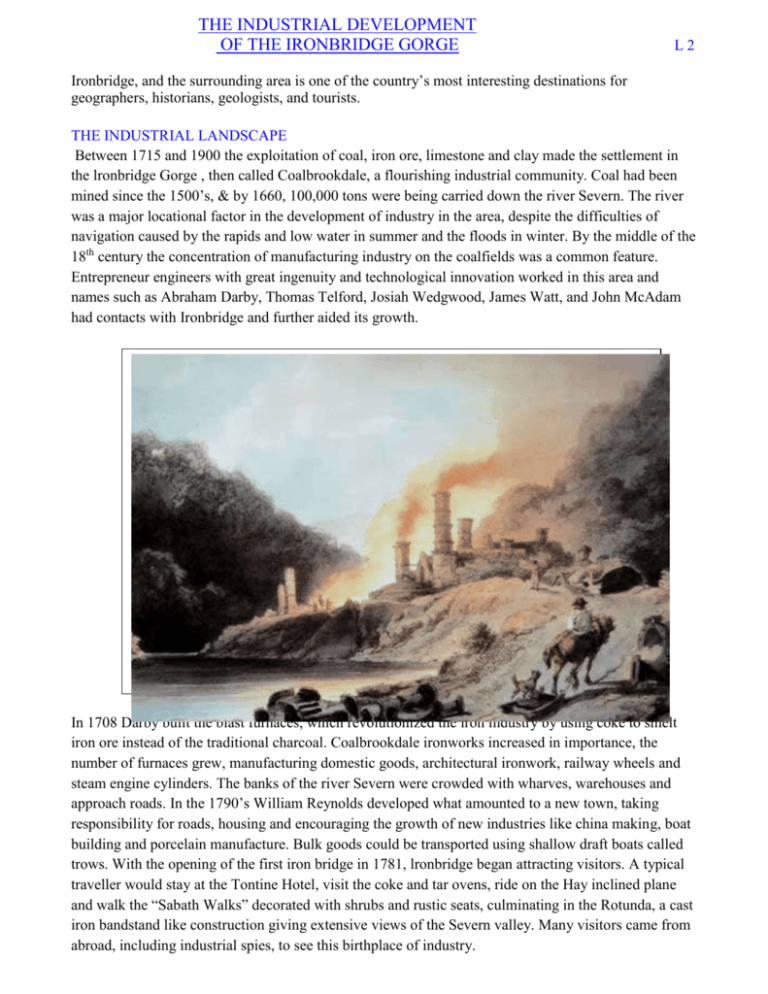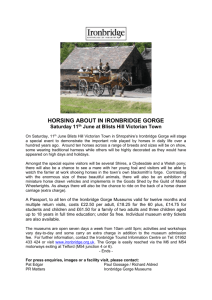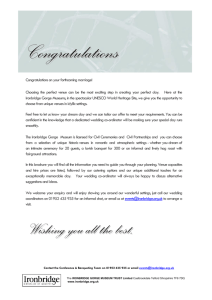A History of The Ironbrid2e Gorse area
advertisement

THE INDUSTRIAL DEVELOPMENT OF THE IRONBRIDGE GORGE L2 Ironbridge, and the surrounding area is one of the country’s most interesting destinations for geographers, historians, geologists, and tourists. THE INDUSTRIAL LANDSCAPE Between 1715 and 1900 the exploitation of coal, iron ore, limestone and clay made the settlement in the lronbridge Gorge , then called Coalbrookdale, a flourishing industrial community. Coal had been mined since the 1500’s, & by 1660, 100,000 tons were being carried down the river Severn. The river was a major locational factor in the development of industry in the area, despite the difficulties of navigation caused by the rapids and low water in summer and the floods in winter. By the middle of the 18th century the concentration of manufacturing industry on the coalfields was a common feature. Entrepreneur engineers with great ingenuity and technological innovation worked in this area and names such as Abraham Darby, Thomas Telford, Josiah Wedgwood, James Watt, and John McAdam had contacts with Ironbridge and further aided its growth. In 1708 Darby built the blast furnaces, which revolutionized the iron industry by using coke to smelt iron ore instead of the traditional charcoal. Coalbrookdale ironworks increased in importance, the number of furnaces grew, manufacturing domestic goods, architectural ironwork, railway wheels and steam engine cylinders. The banks of the river Severn were crowded with wharves, warehouses and approach roads. In the 1790’s William Reynolds developed what amounted to a new town, taking responsibility for roads, housing and encouraging the growth of new industries like china making, boat building and porcelain manufacture. Bulk goods could be transported using shallow draft boats called trows. With the opening of the first iron bridge in 1781, lronbridge began attracting visitors. A typical traveller would stay at the Tontine Hotel, visit the coke and tar ovens, ride on the Hay inclined plane and walk the “Sabath Walks” decorated with shrubs and rustic seats, culminating in the Rotunda, a cast iron bandstand like construction giving extensive views of the Severn valley. Many visitors came from abroad, including industrial spies, to see this birthplace of industry. After 1810 the iron industry suffered a relative decline as production increased in South Wales and the Black Country ( West Midlands ) and the area lost it’s reputation for innovation. By 1850 Coalbrookdale had become important for it’s ornamental castings but the large scale manufacture of decorative tiles began, compensating for the decline in the iron industry. Many people in the late19th and early 20th century viewed Ironbridge as a place, “noticeable for dirt and disorder, made up of old pit shafts, pit mounds, rubbish heaps of brick ends, broken drains, roof and paving tiles, dilapidated houses, sloughy lanes and miry roads.” The area suffered from industrial inertia, manufacturing continued despite the fact that the original locational reasons ( raw materials, transport, skills ) had gone. Industry revived in the war years but then the decline set in and increased with the building of Telford New Town in the 1960’s. In 1959 the old furnace at Coalbrookdale was uncovered and a small museum built. A rebirth of interest was shown in the area. concerned with preserving for the future the monuments of the Industrial Revolution. In 1986 UNESCO designated Ironbridge a World Heritage Site and today 9 museums spread over 6 square miles maintained by the Ironbridge Gorge Museum Trust. ACTIVITY Look at the outline below of Industrial Development at Ironbridge. Complete the missing spaces by using the words in the text box. 1500 to 1700 - Pre Abraham Darby Local .................. Ironstone from the Gorge Local limestone Local wood Water from streams Local river transport Local roads local & small scale, originally using bell pits. iron workings – mainly for agricultural tools. mainly for A...................... mainly as a fuel & agricultural tools. simple water wheels. river Severn very often tracks- poor road link to Watling Street road. 1700 to 1800 – Start of the Industrial Revolution Local coal new innovations. Adit & drift mines into valley sides. Local wood as charcoal new innovations- Iron S................. furnaces.(later coke) Local ..................... used in Coalbrookdale ironworks. Local limestone now used in the iron making process. Water from streams used to power large steam hammers. Local clays used to make tiles at the Jackfield site. Transported pure china clay brought in by .......... from Cornwall to Coalport china works. The River Severn increased river transport. (trows-shallow bottom boats used) Roads improved. .................... roads started. Canals built to transport bulk goods. The Incline Plane constructed to link the Severn to the ................... Union Canal. 1800 to 1900’s – The decline of the Iron Industry Local coal & ironstone .............. importation of coal, coke & I............ Ore. .......... railways helped bring raw materials to the area & distribute finished products. Industrial inertia continued to help keep declining foundries working. Tile & ceramic(china) production helped offset decline in iron industry. Local Iron works started to produce fashionable ornamental iron castings Such as cast iron fireplaces (Aga cooker), trivet stands, foot scrapers & door stops to avoid factory closures. Local ........... labour helped to maintain reputation for quality and helped avoid foundry closures. Tourism started to become fashionable with the Victorians, even to Ironbridge. 1900 to 1960 – Industrial decline continues – dereliction Local industry Many factories have closed with little wharfage traffic. Major unemployment. 1960’s to the Present day – Industrial growth & a rise in tourism ............. New Town created by linking small villages & towns together. New housing & shopping centres built ................... sites that were one waste tips & derelict land. New .................. of roads & motorways linking the area. M54 constructed. New industry attracted to Telford due to the advantages a local labour force, fast road links, attractive factory set up schemes & new shopping centres and schools. Industrial heritage attracted ................... firms to establish in the area. Tourism recognised as very important for the area. Conservation recognised as very important to maintain a sustainable balance. WORD BOX IRON EXHAUSTED STEAM SKILLED TELFORD INFRASTRUCTURE BOAT COAL SMELTING SHROPSHIRE TURNPIKE BROWN FIELD JAPANESE AGRICULTURE IRONSTONE








